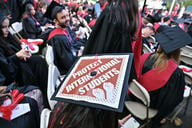You have /5 articles left.
Sign up for a free account or log in.

Cross-functional university teams help improve student success by addressing gaps in supports and resources for students.
Jacob Ammentorp Lund/iStock/Getty Images Plus
Student success has risen to become a top priority for colleges and universities, with more institutions focused on student retention, engagement and postgraduation outcomes as tenets of their campus culture. A 2024 survey of student success leaders found six in 10 respondents indicated their institution is very or extremely effective at making student success an institutional priority.
But for administrators, addressing barriers to student achievement and thriving can turn into a game of whack-a-mole, or “whose job is it anyway?” as students try to navigate an array of distinct offices, departments and divisions with various reporting structures and internal processes.
To combat university silos, some campus leaders have established designated teams and open meetings to create transparency and collaboration among stakeholders. These teams help lead institutionwide innovation and actionable solutions to improve the student experience.
A campuswide team: Ashlie Prioleau, vice president for student success at American University, leads the STAR team, short for Students Thriving and Retention. The STAR team is made up of more than 50 campus leaders from academic units, advising, student affairs and financial aid, among other offices.
STAR team members ensure the campus community can access university resources, evaluate data, reduce duplicate efforts and lead an action plan. They meet every other week to evaluate data and create soft and hard proposals for solutions.
During off weeks, Prioleau leads a student success executive committee to weigh in on STAR proposals. This cadence provides committee members with regular opportunities to discuss problems and opportunities on campus, making STAR responsive and actionable.
“Anyone who talks to me knows I’m big on decision agility, because we don’t have a ton of time to make decisions and we have a lot of people who have to put input into those decisions,” Prioleau told Inside Higher Ed. Now, the silos still exist, but “they don’t feel as far away,” she said.
At the University of Toledo, Angela Paprocki, vice provost and chief of academic operations, created Rocket Roundtables—monthly meetings of various campus department members—after noticing gaps in engagement across higher education within her own career.
“The right hand didn’t know what the left hand was doing,” Paprocki said.
Rocket Roundtables, named after the university’s mascot, the Rockets, include stakeholders from admissions, student affairs, finance and the bursar’s office, as well as faculty senate representatives and students.
Giving learners a seat at the table was of utmost importance to Paprocki. “We would always have committees and no students,” she said. Student representatives rotate throughout the term, depending on their schedule, but there’s almost always at least one present.
The meetings are centered on community members’ questions, with each session addressing a student, parent, staff or other individual’s feedback on systemic challenges from an online submission form.
The University of Texas at San Antonio’s weekly cross-departmental meeting is nicknamed Ruby Tuesday.
“Success is not the responsibility of just one office or division; it’s in our culture, it’s in our DNA,” said Tammy Wyatt, vice provost for student success at UTSA.
Ruby Tuesday team members have been meeting regularly since 2018, reviewing data with members of the student success division, as well as representatives from institutional research, strategic enrollment, undergraduate studies, graduate studies and student affairs, among others.
Creating system-level change requires more than just a team of enthusiastic students, faculty and staff, campus leaders said. It also needs the support of top-level administrators, including the president, provost and Board of Regents.
Making changes: Some of the first challenges Rocket Roundtables addressed were policy issues that were inconsistent across student populations. GPA requirements, for example, varied based on a student’s status as a native learner versus a transfer student.
Toledo also revisited its academic suspension policy to make the process more student-friendly. Often, first-year students faced challenges that would result in their suspension, but the punitive measures would negatively impact their mental health or retention into the second term.
At American University, staff are creating more transparent academic pathways, inventorying available experiential learning opportunities, scaling living-learning communities and piloting success coaching, all as a result of STAR meetings.
Data is key to this work, said Prioleau and Paprocki, who leverage the insights of their institutional research teams to inform and measure the efficacy of interventions. AU created a coordinated care and retention dashboard to serve as an early alert system, providing consolidated data points on the student life cycle for staff and faculty to engage with.
UTSA selects which projects to pursue depending on the number of students impacted by the change, ensuring efforts stretch broadly across the institution. One project focused on tutoring services and reviewing outreach messaging to attract different groups of students, with a focus on male learners, to utilize resources.
But some projects can’t be accomplished by committee; they require a helping hand and personal interaction with students. A 2024 initiative at UTSA hired four graduate students to call disengaged or low-performing undergraduates and check in on their mental well-being and academic progress, providing help as needed.
Another Model
The University of Kentucky holds weekly public meetings in which staff scrape and display data analytics to inform community members and provide direction for student success strategies.
The impact: Giving stakeholders a seat at the table has benefited both University of Toledo employees and the students they serve, Paprocki said.
Faculty get to see how the sausage is made and some of the legal bounds of the institution, Paprocki said. Some of the decisions are not made on a whim but follow state or federal guidance that not all community members are aware of. “It’s really helped them see that we really are here for students,” Paprocki said.
Similarly, students are able to ask questions and be a part of the process. They then often go back to their own groups on campus and share the work administrators are doing, building trust in leadership. Even if concerns can’t be addressed by the Rocket Roundtable as a systemic measure, the team takes the time to respond to all inquiries made through the online form.
Get more content like this directly to your inbox. Subscribe here.




